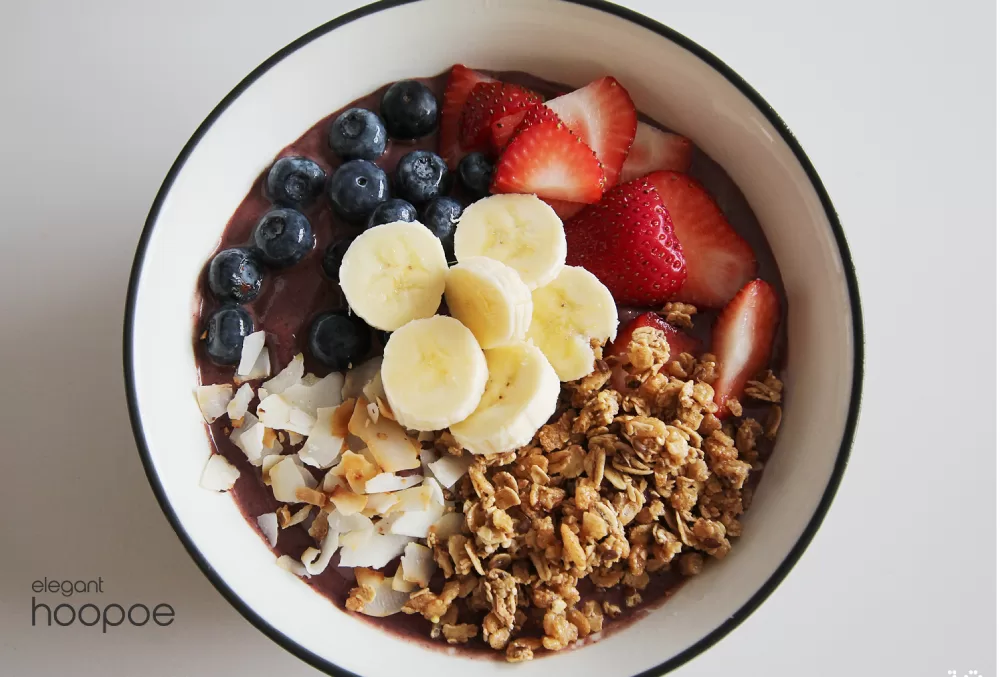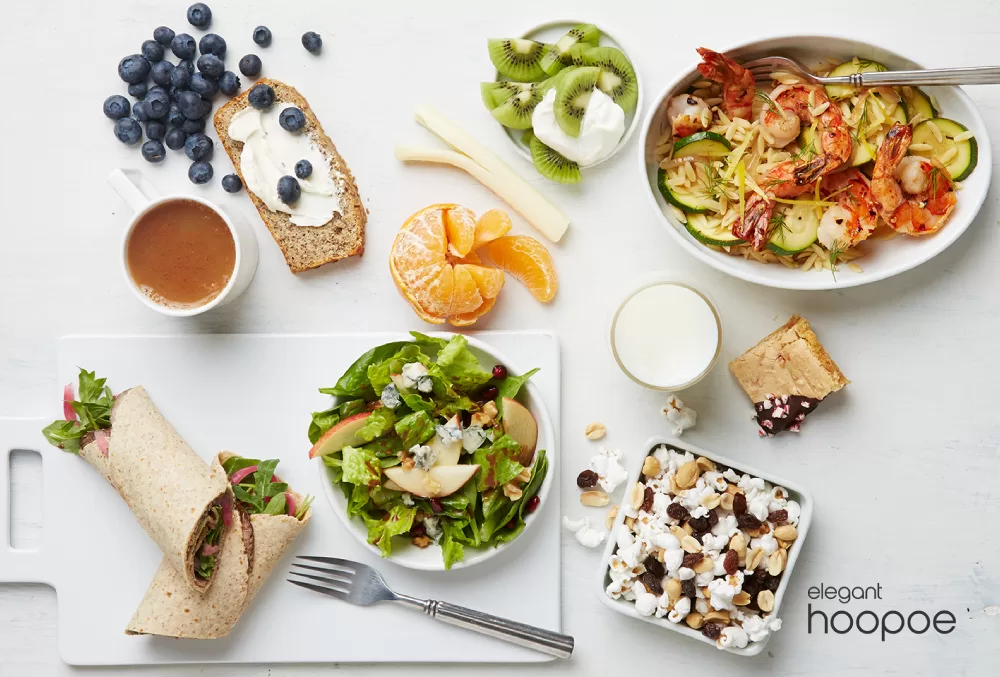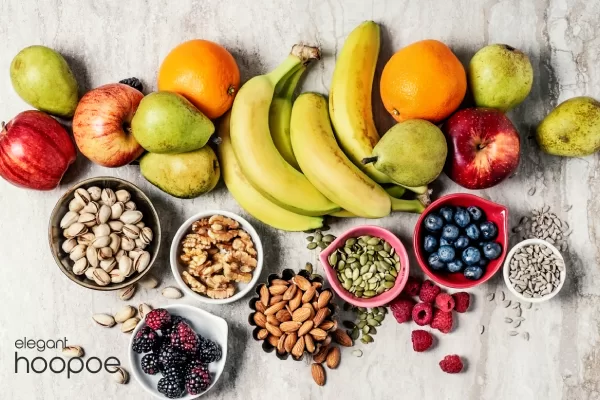The Sirtfood Diet, gaining popularity in recent years, is a unique and intriguing approach to weight loss and overall well-being. Developed by two British nutritionists, Aidan Goggins, and Glen Matten, the diet focuses on incorporating specific “sirtfoods” into your daily meals to activate the body’s natural metabolic pathways and promote fat burning.
What are the best diets to lose weight in 2023?
With a scientific foundation and a celebrity following, the Sirtfood Diet offers a promising way to shed pounds, improve health markers, and boost energy levels. In this introduction, we will explore the key principles of the Sirtfood Diet, its potential benefits, and the science behind its effectiveness, enabling you to decide whether this approach is right for you.
In this article of Elegant Hoopoe, we have explained the Pros and Cons, the health benefits of the Sirtfood Diet, the Principles and the basic tips for starting a Sirtfood diet, and more.
Related services:

What is the Sirtfood Diet?
The Sirtfood Diet is a relatively new and popular diet that emphasizes consuming foods rich in certain nutrients called sirtuin activators. These nutrients are believed to activate sirtuins, a group of proteins in the body that play a role in regulating various metabolic processes, including fat-burning, energy metabolism, and cellular health.
The diet was developed by two British nutritionists, Aidan Goggins and Glen Matten, who introduced it in their book “The Sirtfood Diet.” According to the authors, incorporating sirtuin-activating foods, known as sirtfoods, into your daily meals can have a range of health benefits, including weight loss, improved energy levels, enhanced muscle tone, and increased overall well-being.
Read more: What are the the most important weight loss benefits for men and women
Sirtfoods are predominantly plant-based and include foods like:
- kale
- red wine
- strawberries
- onions
- soy
- parsley
- extra virgin olive oil
- dark chocolate (85% cocoa)
- matcha green tea
- buckwheat
- turmeric
- walnuts
- arugula (rocket)
- bird’s eye chili
- lovage
- Medjool dates
- red chicory
- blueberries
- capers
- coffee
Some indulgences like red wine and dark chocolate, in moderation, are also considered sirtfoods.
The Sirtfood Diet is typically divided into two phases. The first phase lasts for a week and involves a calorie-restricted diet of around 1,000 calories per day. During this phase, you consume green juices and meals rich in sirtfoods. The second phase extends for two weeks and allows for a higher calorie intake of around 1,500 calories per day, with continued emphasis on incorporating sirtfoods into meals.
Note: While the Sirtfood Diet creators make some bold claims that this diet can be super helpful to your weight loss goals and considering it has gained attention for its potential health benefits, more scientific research is needed to validate its claims and evaluate its long-term effectiveness.
How Does the Sirtfood Diet Work?
The Sirtfood Diet works by incorporating specific foods rich in sirtuin activators, also known as sirtfoods, into your daily meals. The idea is that these sirtuin-activating nutrients can mimic the effects of fasting and exercise on the body, leading to various health benefits, including weight loss and improved metabolism.

The diet typically consists of two phases:
- Phase 1: Calorie Restriction and Green Juices
During the first phase, which lasts for one week, the calorie intake is restricted to approximately 1,000 calories per day. This phase aims to kickstart weight loss and activate the body’s sirtuin pathways. The diet plan includes consuming three sirtfood green juices per day, along with one sirtfood-rich meal. The green juices are made from a combination of sirtfoods such as kale, arugula, celery, parsley, green tea, lemon juice, and a small amount of apple.
- Phase 2: Increased Calorie Intake and Sirtfood Meals
In the second phase, which extends for two weeks, the calorie intake is increased to around 1,500 calories per day. This phase aims to maintain weight loss while continuing to incorporate sirtfoods into meals. The diet plan includes three sirtfood-rich meals per day, which can include a variety of vegetables, fruits, whole grains, lean proteins, and sirtfood spices like turmeric.
The emphasis on consuming sirtfoods throughout both phases is believed to activate sirtuins, which may promote fat burning, increase metabolism, and improve overall health. The specific combination of sirtfoods and the calorie restriction in the initial phase are key elements of the diet’s proposed mechanism.
Related article: MIND Diet for Weight Loss + Free Sample Meal Plans
The Science behind the Sirtfood Diet
The Sirtfood Diet is founded on the premise that certain foods rich in sirtuin-activating nutrients, known as sirtfoods, can activate sirtuins in the body. Sirtuins are a group of proteins that play a role in regulating various metabolic processes, including fat metabolism, energy expenditure, and cellular health. By activating sirtuins, the Sirtfood Diet aims to stimulate beneficial physiological effects that can lead to weight loss and improved health.

The key nutrient in sirtfoods that is believed to activate sirtuins is a compound called resveratrol. Resveratrol is found in foods like red wine and dark chocolate, both of which are included as sirtfoods in the diet. Resveratrol has been studied for its potential anti-inflammatory, antioxidant, and anti-aging properties.
Additionally, sirtfoods are typically rich in other plant compounds, such as flavonoids and polyphenols, which have been associated with various health benefits. These compounds are known for their antioxidant and anti-inflammatory effects, which can contribute to overall well-being.
Some studies conducted on isolated cells and animals have suggested that sirtuins and sirtuin-activating compounds may have beneficial effects on metabolism, cellular health, and longevity. However, it’s important to note that most of this research is in its early stages, and more human studies are needed to fully understand the impact of sirtuins and sirtuin-activating compounds on human health.
Critics of the Sirtfood Diet argue that the current scientific evidence is limited, and the specific effects of sirtfoods on human health and weight loss are not well-established. They emphasize the need for further research to validate the claims made by proponents of the diet.
Key Principles of the Sirtfood Diet
- Incorporating Sirtfoods:
Sirtfoods include a variety of plant-based foods such as kale, arugula, parsley, green tea, strawberries, onions, soy, turmeric, and walnuts. Red wine and dark chocolate, in moderation, are also considered sirtfoods.
- Calorie Restriction:
The Sirtfood Diet involves a period of calorie restriction in its initial phase, which typically lasts for one week. During this phase, the calorie intake is limited to around 1,000 calories per day. The purpose of this restriction is to kickstart weight loss and activate the body’s sirtuin pathways.
- Green Juices:
In the first phase of the diet, individuals are encouraged to consume three sirtfood green juices per day. These juices are made from a combination of sirtfoods such as kale, arugula, celery, parsley, green tea, lemon juice, and a small amount of apple. Green juices provide essential nutrients while keeping calorie intake low.
- Sirtfood-Rich Meals:
In both phases of the diet, sirtfoods are incorporated into meals to maximize their consumption. The focus is on creating meals that are rich in sirtfoods, including a variety of vegetables, fruits, whole grains, lean proteins, and sirtfood spices like turmeric. The goal is to continue activating sirtuins and reaping their potential benefits.
- Gradual Calorie Increase:
After the initial phase of calorie restriction, the Sirtfood Diet allows for a gradual increase in calorie intake. The second phase extends for two weeks and typically involves consuming around 1,500 calories per day. This phase aims to maintain weight loss while providing a slightly higher calorie allowance.
- Combination with Exercise:
Exercise, along with the consumption of sirtfoods, is believed to further activate sirtuins and contribute to positive metabolic effects.
Related article: Plant-based diet for Weight Loss + Free Sample Meal Plans
Pros and Cons of a Sirtfood Diet
No one can deny how good these sirtfoods are to our overall health condition so like any diet, the Sirtfood Diet has its own set of potential pros and cons. Here are some commonly mentioned advantages and disadvantages of the Sirtfood Diet:
Health benefits of sirtfood diet

- Weight Loss: The Sirtfood Diet’s calorie restriction and emphasis on nutrient-dense foods may lead to initial weight loss. This can be appealing to individuals looking to shed excess pounds quickly! Read more about how to lose weight quickly in this article.
- Nutrient-Rich Foods: The diet encourages the consumption of plant-based, nutrient-rich foods like fruits, vegetables, and whole grains, which provide essential vitamins, minerals, and antioxidants.
- Sirtuin Activation: Sirtfoods are believed to activate sirtuins, which may have potential health benefits, including improved metabolism, cellular health, and anti-aging effects. While further research is needed to fully understand these effects, the concept is intriguing.
- Emphasis on Healthy Eating: The Sirtfood Diet promotes the inclusion of whole, unprocessed foods in meals, which can help individuals develop healthier eating habits and make more conscious food choices.
- Healthier Heart: eating sirtfoods might help your body to fight inflammation, other than that it is said to be effective against heart diseases.
- Lower Blood pressure: since green tea is one of the main juices in this diet, it can be helpful to lower the blood pressure and reduce the risk of stroke.
- Antioxidants: This diet not only does not restrict the consumption of antioxidants rich foods, but also encourages it. eating more sirtfoods that are filled with these substances will help the body to get rid of radical damages.
Risk and Possible side effects of sirtfood diet
- Calorie Restriction: The initial phase of the Sirtfood Diet involves a significant calorie restriction, which can be challenging and may lead to feelings of hunger, fatigue, and difficulty adhering to the diet long term. Eating 1500 calories a day is not suitable for lots of people and even less than that needs to be under a healthcare supervision.
- Limited Evidence: The scientific evidence supporting the specific claims and effectiveness of the Sirtfood Diet is limited. More research is needed to validate its claims and understand its long-term effects on weight loss and overall health.
- Potential Nutrient Imbalances: Depending on individual food choices and meal planning, there is a risk of nutrient imbalances, especially if the diet is not carefully balanced and varied. It is important to ensure adequate intake of all essential nutrients.
- Sustainability: Some individuals may find it challenging to sustain the strict guidelines and specific food choices of the Sirtfood Diet over the long term. Long-term adherence and maintenance of results can be difficult for many.
- Individual Variations: Different individuals may have varying responses to the diet. What works for one person may not work the same way for another, highlighting the need for personalized approaches to nutrition.
- Blood-sugar: As we have explained before, different types of juices are essential part of this diet and drinking them might lead to more blood sugar especially if they are carrying processed sugar in them. So it is best to make those juices in your own home and try to drink them moderately as they also can be harmful to your teeth.
- Lack of Long-Term Data: Since the Sirtfood Diet is a relatively new concept, there is limited data on its long-term effects on health, weight management, and disease prevention.
Note that if the diet is only followed for the suggested time of three weeks it is more likely to be safe for most people since calorie restriction will affect the body health situation if continued for long term.
Related article: What is MAYR Diet? Full Guide.
Incorporating Sirtfoods into Your Meals
Incorporating sirtfoods into your meals is a key aspect of the Sirtfood Diet. These foods are rich in sirtuin-activating nutrients that are believed to offer potential health benefits.

Some tips for incorporating sirtfoods into your meals are:
- Choose a Variety of Sirtfoods: Aim to include a diverse range of Sirtfoods in your meals to maximize the intake of different nutrients. Some examples of sirtfoods include kale, arugula, parsley, green tea, strawberries, onions, soy, turmeric, walnuts, red wine, and dark chocolate.
- Build Sirtfood Salads: Create vibrant and nutrient-packed salads using a combination of Sirtfoods. Start with a base of leafy greens like kale or arugula, and add in other sirtfoods such as onions, strawberries, and walnuts. Drizzle with a dressing made from sirtfood ingredients like olive oil, lemon juice, and turmeric.
- Sirtfood Stir-Fries or Roasted Vegetables: Incorporate sirtfoods into stir-fries or roasted vegetable dishes. Use onions, kale, and turmeric as flavor enhancers, along with other vegetables of your choice. Add in a source of lean protein like tofu or chicken to make it a complete meal.
- Green Smoothies: Prepare green smoothies using sirtfoods like kale, arugula, green tea, and parsley. Blend them with other ingredients such as strawberries or avocado for added flavor and creaminess. You can also add a scoop of sirtfood-rich protein powder or a tablespoon of sirtfood spices like turmeric.
- Sirtfood Spices and Seasonings: Enhance the flavor of your meals by incorporating sirtfood spices and seasonings. Turmeric, garlic, and rosemary are examples of sirtfood spices that can be added to various dishes like soups, stews, and roasted vegetables.
- Sirtfood Snacks: Choose sirtfood snacks for healthy and nutritious between-meal options. Snack on a handful of walnuts, a piece of dark chocolate (in moderation), or a bowl of strawberries to satisfy your cravings while incorporating sirtfoods into your diet.
One Recommendation
Combine sirtfoods with other nutritious foods to ensure a well-balanced diet that meets your nutritional needs. It’s also important to consider portion sizes and overall calorie intake to maintain a healthy balance.
Foods to Eat on a Sirtfood Diet

Some foods commonly included in a Sirtfood Diet include:
- Leafy Greens: Kale, arugula, spinach, and other leafy greens are excellent sources of sirtuin-activating nutrients. They can be incorporated into salads, stir-fries, smoothies, or sautéed as a side dish.
- Eggs: although eggs are not considered to be a in this particular food group, they are full of all types of proteins that makes them important to almost all kinds of diets including sirtfood diet.
- Cruciferous Vegetables: Broccoli, cauliflower, Brussels sprouts, and cabbage are all nutrient-dense sirtfoods. They can be roasted, steamed, or added to stir-fries and salads.
- Brightly Colored Berries: Strawberries, blueberries, and raspberries are packed with antioxidants and are considered sirtfoods. Enjoy them as a snack, in smoothies, or as toppings for yogurt or oatmeal.
- Onions and Garlic: Both onions and garlic contain compounds that can activate sirtuins. They can be used as flavor enhancers in various dishes, such as soups, stews, stir-fries, or roasted vegetables.
- Soy Products: Foods like tofu, tempeh, and edamame are rich in protein and are considered sirtfoods. Incorporate them into stir-fries, salads, or use tofu as a meat substitute in dishes like stir-fry or curries.
- Green Tea: Green tea is a well-known sirtfood due to its high concentration of catechins. Enjoy green tea as a beverage or use it as a base for smoothies or herbal infusions
- Dark Chocolate: Dark chocolate, with a high cocoa content (70% or higher), is considered a sirtfood. Enjoy a small portion as an occasional treat to satisfy your sweet tooth.
- Walnuts: Walnuts are a good source of healthy fats and are considered a sirtfood. Snack on a handful of walnuts or sprinkle them over salads and oatmeal.
- Turmeric: Turmeric is a spice known for its anti-inflammatory properties and sirtuin-activating effects. Add turmeric to curries, roasted vegetables, or smoothies to incorporate it into your meals.
- Extra Virgin Olive Oil: Extra virgin olive oil, rich in healthy monounsaturated fats, is a sirtfood that can be used in salad dressings, sautéing, or drizzling over roasted vegetables.
Related article: MIND Diet for Weight Loss + Free Sample Meal Plans
Foods to Avoid on the Sirtfood Diet
While the Sirtfood Diet emphasizes the inclusion of sirtfoods in meals, there are no strict guidelines on foods to avoid. However, to make the most of the Sirtfood Diet and support overall health, it’s beneficial to limit or avoid certain foods that are typically considered less nutritious. Here are some examples:
- Processed Foods: Processed foods, such as packaged snacks, fast food, sugary beverages, and processed meats, are often high in unhealthy fats, added sugars, and sodium. These should be limited or avoided as they provide little nutritional value. In fact, eating processed foods is one the most common weight loss mistake that people make.
- Highly Refined Grains: Foods made from refined grains, like white bread, white rice, and processed cereals, have had their fiber and nutrient content stripped away. Opt for whole grains like quinoa, brown rice, oats, and whole wheat bread instead.
- Sugary Foods and Beverages: Foods and drinks with added sugars, such as candy, soda, pastries, and sweetened cereals, should be limited or avoided. These items can contribute to weight gain and have negative effects on health.
- Unhealthy Fats: Limit the intake of foods high in unhealthy fats, including fried foods, fatty cuts of meat, full-fat dairy products, and commercially baked goods. Instead, choose sources of healthy fats like avocados, nuts, seeds, and olive oil.
- Excessive Alcohol: While red wine is considered a sirtfood, it’s important to consume alcohol in moderation. Excessive alcohol consumption can have detrimental effects on health and weight management.
- High-Calorie Foods with Low Nutritional Value: Foods that are high in calories but low in nutrients, such as sugary snacks, fried foods, and processed desserts, should be minimized. Opt for nutrient-dense sirtfoods and whole foods instead.
Sample One-day Meal Plan for The Sirtfood Diet
Breakfast:
- Sirtfood Green Smoothie: Blend a handful of kale, a small handful of arugula, a small handful of parsley, half a green apple, a squeeze of lemon juice, and a cup of green tea. Optionally, add a scoop of sirtfood-rich protein powder.
- A boiled egg on the side for added protein.
Morning Snack:
- A handful of walnuts and a few strawberries.
Lunch:
- Sirtfood Salad: Mix a base of kale and arugula, sliced strawberries, chopped red onions, and walnuts. Drizzle with a dressing made from olive oil, lemon juice, and a pinch of turmeric.
- Grilled chicken breast or baked tofu on top for protein.
Evening Snack:
- A cup of green tea and a small piece of dark chocolate (70% cocoa or higher).
Dinner:
- Baked salmon seasoned with turmeric and served with a side of steamed broccoli and cauliflower.
- Quinoa cooked with a dash of turmeric and seasoned with herbs like rosemary or thyme.
Bed-Time Dessert:
- Greek yogurt with a sprinkle of chopped walnuts and a few blueberries.
Note: This sample meal plan is for illustrative purposes only and should not replace personalized advice from a healthcare professional or a registered dietitian. They can provide guidance tailored to your specific dietary needs and goals.
Sample One-week Meal Plan for The Sirtfood Diet
Here’s a sample one-week meal plan for the Sirtfood Diet to give you an idea of how you can incorporate sirtfoods into your meals. Remember to adjust portion sizes and make modifications based on your individual calorie and nutritional needs:
Day 1
Breakfast:
- Sirtfood Green Smoothie: Kale, arugula, parsley, green tea, half a green apple, and a squeeze of lemon juice.
- Boiled egg.
Lunch:
- Sirtfood Salad: Mixed greens, strawberries, red onions, walnuts, and a dressing made from olive oil, lemon juice, and turmeric.
- Grilled chicken breast or baked tofu.
Evening Snack:
- Handful of walnuts and a few blueberries.
Dinner:
- Baked salmon with turmeric, served with roasted cauliflower and steamed broccoli.
- Quinoa cooked with a pinch of turmeric.
Day 2
Breakfast:
- Sirtfood Green Smoothie: Spinach, kale, parsley, green tea, half a green apple, lemon juice.
- Greek yogurt topped with sliced strawberries and a sprinkle of chopped walnuts.
Lunch:
- Sirtfood Stir-Fry: Tofu or chicken breast stir-fried with kale, broccoli, onions, and soy sauce.
- Brown rice or cauliflower rice.
Evening Snack:
- Carrot sticks with hummus.
Dinner:
- Grilled chicken breast seasoned with rosemary, served with a side of roasted Brussels sprouts and a mixed green salad.
Day 3
Breakfast:
- Sirtfood Green Smoothie: Kale, arugula, parsley, green tea, half a green apple, lemon juice.
- Whole grain toast topped with avocado and sliced tomatoes.
Lunch:
- Sirtfood Salad: Mixed greens, strawberries, red onions, walnuts, and a dressing made from olive oil, lemon juice, and turmeric.
- Grilled salmon or baked tempeh.
Evening Snack:
- Green tea and a small piece of dark chocolate.
Dinner:
- Turkey chili loaded with sirtfoods like onions, garlic, tomatoes, and kidney beans.
- Serve with a side of steamed asparagus.
Day 4
Breakfast:
- Sirtfood Green Smoothie: Spinach, kale, parsley, green tea, half a green apple, lemon juice.
- Scrambled eggs with chopped onions and tomatoes.
Lunch:
- Sirtfood Stir-Fry: Shrimp or tofu stir-fried with broccoli, bell peppers, onions, and soy sauce.
- Quinoa cooked with a pinch of turmeric.
Evening Snack:
- Handful of almonds and a few raspberries.
Dinner:
- Grilled chicken breast marinated with lemon and herbs, served with a side of roasted sweet potatoes and a mixed green salad.
Day 5
Breakfast:
- Sirtfood Green Smoothie: Kale, arugula, parsley, green tea, half a green apple, lemon juice.
- Oatmeal topped with sliced bananas and a sprinkle of cinnamon.
Lunch:
- Sirtfood Salad: Mixed greens, strawberries, red onions, walnuts, and a dressing made from olive oil, lemon juice, and turmeric.
- Baked tofu or grilled chicken breast.
Evening Snack:
- Carrot sticks with hummus.
Dinner:
Baked cod seasoned with turmeric and served with sautéed kale and quinoa.
Day 6
Breakfast:
- Sirtfood Green Smoothie: Spinach, kale, parsley, green tea, half a green apple, lemon juice.
- Scrambled eggs with chopped onions and tomatoes.
Lunch:
- Sirtfood Salad: Mixed greens, strawberries, red onions, walnuts, and a dressing made from olive oil, lemon juice, and turmeric.
- Grilled salmon or baked tempeh.
Evening Snack:
- Handful of almonds and a few raspberries.
Dinner:
- Grilled chicken breast marinated with lemon and herbs, served with a side of roasted sweet potatoes and a mixed green salad.
Day 7
Breakfast:
- Sirtfood Green Smoothie: Kale, arugula, parsley, green tea, half a green apple, lemon juice.
- Oatmeal topped with sliced bananas and a sprinkle of cinnamon.
Lunch:
- Sirtfood Stir-Fry: Shrimp or tofu stir-fried with broccoli, bell peppers, onions, and soy sauce.
- Quinoa cooked with a pinch of turmeric.
Evening Snack:
- Greek yogurt with a drizzle of honey and a few sliced strawberries.
Dinner:
- Baked cod seasoned with turmeric and served with sautéed kale and quinoa.
Note: This meal plan is just a sample and can be customized to suit your taste and dietary requirements.
Related article: 80/20 Diet Plan, What Is Weekend Diet?
Who Should Avoid The Sirtfood Diet?
While the Sirtfood Diet is generally considered safe for most healthy individuals, certain groups of people should exercise caution or avoid it altogether, such as:
- Pregnant or Breastfeeding Women: During pregnancy and breastfeeding, it’s important to prioritize a well-rounded and balanced diet that provides all essential nutrients for both the mother and the baby. The Sirtfood Diet may not provide adequate calories and nutrients required during this crucial period.
- Underweight Individuals: If you are already underweight or have a history of eating disorders, the Sirtfood Diet’s potential calorie restriction may not be suitable for you. It’s important to prioritize a healthy and balanced approach to nutrition and consult with a healthcare professional or registered dietitian.
- Individuals with Medical Conditions: If you have any pre-existing medical conditions, such as diabetes, cardiovascular diseases, kidney problems, or any other chronic health condition, it’s important to consult with a healthcare professional or registered dietitian before starting the Sirtfood Diet. They can guide how to incorporate sirtfoods safely into your diet while considering your specific health needs.
- Individuals on Medications: Certain medications may interact with specific foods or compounds found in sirtfoods. If you are taking any medications, it’s crucial to consult with your healthcare provider or a registered dietitian to ensure that the Sirtfood Diet does not interfere with your medications or medical condition.
- Those with Food Allergies or Sensitivities: If you have known food allergies or sensitivities to any of the sirtfoods, it’s important to make appropriate substitutions or avoid those particular foods. Always prioritize your health and well-being when selecting foods for your diet.
Is Sirtfood Diet Good for weight loss?
The Sirtfood Diet gained attention for its potential association with weight loss. Here’s how the Sirtfood Diet may contribute to weight loss:
- Caloric Restriction: The initial phase of the Diet involves consuming a low-calorie diet, typically around 1,000 to 1,500 calories per day. This calorie restriction can create a calorie deficit, leading to weight loss.
- Increased Satiety: The Diet emphasizes foods rich in sirtuin-activating nutrients, such as fruits, vegetables, and whole grains. These foods are generally high in fiber, which can promote feelings of fullness and satiety. This may contribute to weight loss by reducing overeating and snacking between meals.
- Potential Metabolic Effects: Sirtuins have been associated with various metabolic processes in the body, including metabolism, energy expenditure, and fat storage. Some research suggests that activating sirtuins through dietary means may potentially have positive effects on weight management. However, more studies are needed to fully understand the extent of these effects and their practical application in weight loss.
- Focus on Nutrient-Dense Foods: The Diet promotes the consumption of nutrient-dense foods, including fruits, vegetables, whole grains, and lean proteins. These foods tend to be lower in calories and higher in essential nutrients compared to processed and high-calorie foods. By emphasizing these foods, the Sirtfood Diet can support a balanced and healthy approach to weight loss.
Notes:
Individual results may vary, and weight loss is influenced by various factors, including genetics, activity levels, overall calorie intake, and adherence to the diet. Sustainable weight loss is typically achieved through long-term lifestyle changes that incorporate a balanced diet, regular physical activity, and behavior modifications.
If you are considering the Sirtfood Diet for weight loss, it’s recommended to consult with a healthcare professional or registered dietitian. They can provide personalized guidance, help you create a safe and effective plan, and monitor your progress to ensure it aligns with your specific needs and goals.
Low-calorie intake should be done under the supervision of a healthcare professional or registered dietitian to ensure it is safe and nutritionally adequate.
Comparing the Sirtfood Diet to Other Popular Diets
Diet | Key Principles | Pros | Cons |
| Sirtfood Diet | Emphasizes sirtuin-activating nutrients | – Focus on whole foods – May support weight loss – Variety of plant-based foods – Emphasis on nutrient-dense foods | – Potential nutrient deficiencies – Initial phase involves low-calorie intake – Limited long-term evidence Mediterranean |
| Mediterranean Diet | Based on traditional Mediterranean eating patterns | – Emphasizes whole foods and plant-based meals Rich in fruits, vegetables, whole grains, and healthy fats – Linked to heart health and overall well-being – Flexible and adaptable to various preferences
| – Individual results may vary – Requires meal planning and cooking skills – May not be suitable for strict vegetarians – Portion control is important |
| Ketogenic Diet | Very low carbohydrate, high fat intake | – Can lead to rapid weight loss – May help control blood sugar levels – Can increase satiety and reduce cravings – May have benefits for certain medical conditions | – Initial side effects (keto flu) may occur – Restrictive and challenging to sustain – Requires strict adherence to carb intake – Nutrient deficiencies if not planned carefully |
| Paleo Diet | Based on a hunter-gatherer approach | – Emphasizes whole, unprocessed foods – High in fruits, vegetables, lean meats, and seafood – Eliminates processed foods and added sugars – Can lead to weight loss and improved blood markers – Promotes a focus on quality and unprocessed foods | – Limited research on long-term effects – Eliminates entire food groups (e.g., grains) – May be challenging for vegetarians |
Combining Exercise with the Sirtfood Diet

By combining exercise with the Sirtfood Diet, you can reap both the dietary and exercise-related health advantages, because:
Regular exercise, when combined with a calorie-controlled diet like the Sirtfood Diet, can enhance weight loss results. Exercise helps create a greater calorie deficit by burning additional calories, leading to increased fat loss and improved body composition.
Exercise increases your overall energy expenditure, which can support weight loss and boost metabolism. It can help you burn more calories throughout the day, even when you’re not actively exercising.
Adding exercise to your routine while following the Sirtfood Diet can improve cardiovascular fitness, muscular strength, and endurance, leading to increased overall fitness levels, better physical performance, and enhanced body composition.
Regular physical activity has numerous health benefits, including reduced risk of chronic diseases, improved cardiovascular health, better mood, and enhanced mental well-being.
Incorporating exercise into your routine can provide a balance to the Sirtfood Diet by promoting overall fitness and well-being. It adds variety to your daily activities and helps maintain a healthy and active lifestyle.
5 Tips combining exercise with the Sirtfood Diet:
- Choose exercises that you enjoy and that align with your fitness level and abilities. This can include activities like walking, running, swimming, cycling, strength training, or group fitness classes.
- Aim for a combination of cardiovascular exercises (such as brisk walking or jogging) and strength training exercises (such as lifting weights or bodyweight exercises) to achieve a well-rounded fitness routine.
- Listen to your body and adjust your exercise intensity and duration accordingly. Gradually increase the intensity and duration of your workouts as your fitness level improves.
- Stay hydrated and fuel your body with nutritious foods to support your exercise performance and recovery.
- Consider consulting with a fitness professional or personal trainer to develop an exercise plan tailored to your goals and needs.
Note: Incorporating exercise into your routine is not mandatory for the Sirtfood Diet, but it can enhance the overall benefits of the diet and contribute to your overall health and well-being.
Related article: Yoga for Weight Loss: How Yoga Helps You Lose Weight?
Top 10 Tips and Strategies for Success on the Sirtfood Diet
To increase your chances of success while following the Sirtfood Diet, consider the following tips and strategies:
- Take time to plan your meals and snacks. This will help you ensure that you have the necessary ingredients on hand and can stick to the recommended foods. Meal prepping can also save time during busy days.
- Try to incorporate a variety of sirtuin-activating foods into your meals. This will provide different nutrients, make your meals more enjoyable, and prevent food boredom.
- Focus on consuming nutrient-dense foods (fruits, vegetables, whole grains, lean proteins, and healthy fats) that are high in sirtuin-activating compounds and provide essential vitamins, minerals, and fiber.
- While the Sirtfood Diet doesn’t require strict calorie counting, it’s important to be mindful of your overall caloric intake. The initial phase of the diet involves calorie restriction, so pay attention to portion sizes and aim for a balance between the recommended foods.
- Drink plenty of water throughout the day to stay hydrated. Water can help curb hunger, support digestion, and maintain overall health.
- Incorporate regular physical activity into your routine to enhance weight loss, promote overall health, and complement the effects of the Sirtfood Diet.
- If you’re unsure about the diet or have specific dietary needs or health conditions, consider consulting with a registered dietitian. They can provide personalized guidance, ensure nutritional adequacy, and help you tailor the diet to your individual needs.
- While the Sirtfood Diet may offer short-term benefits, focus on adopting long-term healthy habits. Use the principles of the diet to guide your food choices beyond the specific diet plan.
- Avoid restricting yourself too much or feeling deprived, as this can lead to unsustainable eating patterns.
- Keep track of your progress and how your body responds to the diet. Adjust your approach as needed to ensure that you’re achieving your goals and feeling your best.
Concluding Remarks
As we said the Sirtfood Diet is a dietary approach that focuses on consuming foods rich in sirtuin-activating compounds, which are believed to have potential health benefits. While the diet has gained popularity and has its supporters, it’s important to approach it with a balanced perspective.
The Diet promotes the consumption of nutrient-dense foods like fruits, vegetables, and whole grains, which can contribute to a healthy diet. It also incorporates elements of calorie restriction during the initial phase. However, it’s essential to consider the potential risks, challenges, and limitations associated with this diet.
The scientific evidence supporting the specific claims of the Diet is limited, and more research is needed to fully understand its effectiveness and long-term sustainability. Individual experiences with the diet can vary, and it may not be suitable for everyone, especially those with specific medical conditions or dietary restrictions.
As with any dietary approach, it’s important to prioritize overall health, balanced nutrition, and long-term sustainable habits. Consulting with a healthcare professional or dietitian can provide personalized guidance and support in making informed decisions about your dietary choices.
Remember that a healthy lifestyle involves more than just following a specific diet. It encompasses regular physical activity, stress management, adequate sleep, and a well-rounded approach to overall well-being. Making gradual, sustainable changes to your eating habits and adopting a balanced approach to nutrition is key to achieving long-term health and wellness.







